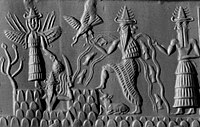アヌンナキ

アヌンナキ (Anunnaki) 、あるいはアヌナキ (Anunaki) 、アンヌナキ (Annunaki) 、アヌナ (Anunna) 、アナナキ (Ananaki) は、古代シュメール、アッカド、アッシリア、バビロニアの一群の神々である。[1]。この神々に関する最古のシュメール語の記録は、アッカド帝国以後の時代のもので、アヌンナキは パンテオンでも最も強力な神々で、天空の神アヌと大地の女神キの子孫であり、人間の運命を司った。20世紀の後半以降、この神々はアーヴィング・フィンケルのようなシュメール語研究家や考古学者たちにとっての新たな研究対象となってきた。
語源

「アヌンナキ」という名は、シュメールの天空神のアヌに由来する[2]。この名の表記は様々であり、"da-nuna"、"da-nuna-ke4-ne"、"da-nun-na"などで、おそらく「アヌの子孫」を意味するが、初期の、特にシュメールの文書では、広く「神々」を意味する語として使われていた[1]。
アヌンナキの神々は、大地の女神キとアヌの子孫であると信じられていた[1] 。サミュエル・ノア・クレーマー(英語版)は、キとはシュメールの母神のニンフルサグのことだとしており、元々は同一神だったと説明している[3][4]。アヌンナキの中でもっとも古い神は大気の神エンリルであり[5]、シュメールのパンテオンでは主神だった[6]。シュメール人は、エンリルの誕生以前は、天空と大地は分離せず一体だったと信じていた[7]。その後、エンリルが天空と大地を二つに分かち[7] 、エンリルは大地をとり[8][8]、父アヌが天空をとった[8]。
崇拝と図像
アヌンナキは主に文学的な文書で言及されている[9]。彼らの信仰が存在していたことを示す考古学的な証拠は極めて少ない[9][10]。これは、アヌンナキに含まれる神々は、それぞれ独立した信仰対象であったことを示している可能性がある[11]。
同様に、集団としてのアヌンナキを描いた事物も未発見である[11]。ただし、属する神を個別に描いたものであれば確認されている[11]。古代メソポタミアの神々はほとんどが擬人化されていた[12]。神々は並外れた力を有していると考えられていた[12]し、物理的なサイズについても、とてつもなく巨大だと想像されていた[12]。
神話
シュメール

アヌンナキという言葉の現存最古の使用例はラガシュ王グデアの治世(紀元前2144年から2124年頃)とウル第三王朝の間に書かれた碑文にある[9][11]。初期の文書では、この用語はシュメール神話の中でも最有力かつ最重要な神々、つまり天空神アンの子孫を指している[9][13]。 この一群の神々にはおそらく「運命を定める7人の神々」が含まれていた[14]。アン、エンリル、エンキ、ニンフルサグ、ナンナ、ウトゥ、イナンナの7柱が知られている[15]。
シュメールの重要な神は、ほぼ全員がそれぞれ特定の都市の守護神でもあった[16]。その都市の国益を守るものとして望まれていた[16]。その都市の神殿が、その神の永久の住まいであると信じられていた[17]。
フルリとヒッタイト
フルリのフルリ神話(英語版)と、ヒッタイト(紀元前2千年紀の半ばから後半にかけて栄えた)のヒッタイト神話では、最古の世代の神々が、より新しい神々によって、地下世界(冥界)に追放されたと信じられていた[18][19]。冥界は女神レルワニが支配しているとされた[19]。ヒッタイトの筆記者はこれらの神々がアヌンナキだとみなしていた[18][20]。
古代フルリ語では、アヌンナキは「かつての古き神々」[21]か、「大地の神々」karuileš šiuneš[21] と呼ばれている。ヒッタイトやフルリの条約文では、しばしば、誓約事項を遵守するため、古い神々への宣誓がなされていた[18][21]。
脚注
- ^ a b c Black & Green 1992, p. 34.
- ^ Leemings 2009, p. 21.
- ^ Kramer 1961, p. 41.
- ^ Kramer 1963, p. 122.
- ^ Coleman & Davidson 2015, p. 108.
- ^ Kramer 1983, pp. 115–121.
- ^ a b Kramer 1961, pp. 72–73.
- ^ a b c Kramer 1961, pp. 72–75.
- ^ a b c d Leick 1998, p. 8.
- ^ Falkenstein 1965, pp. 127–140.
- ^ a b c d Brisch 2016.
- ^ a b c Black & Green 1992, p. 93.
- ^ Katz 2003, p. 403.
- ^ Kramer 1963, p. 123.
- ^ Kramer 1963, pp. 122–123.
- ^ a b Nemet-Nejat 1998, p. 179.
- ^ Nemet-Nejat 1998, p. 187-189.
- ^ a b c Leick 1998, p. 141.
- ^ a b Van Scott 1998, p. 187.
- ^ Collins 2002, p. 225.
- ^ a b c Archi 1990, p. 114.
参考文献
- Amin, Osama Shukir Muhammed (31 March 2014), Copper alloy foundation figurines with pegs representing Gods, https://www.ancient.eu/image/2451/
- Archi, Alfonso (1990), “The Names of the Primeval Gods”, Orientalia, NOVA (Rome, Italy: Gregorian Biblical Press) 59 (2): 114–129, JSTOR 43075881, https://jstor.org/stable/43075881
- Black, Jeremy; Green, Anthony (1992), Gods, Demons and Symbols of Ancient Mesopotamia: An Illustrated Dictionary, London, England: The British Museum Press, ISBN 0-7141-1705-6
- Brisch, Nicole (2016), Anunna (Anunnaku, Anunnaki) (a group of gods), University of Pennsylvania Museum, オリジナルの2019-09-03時点におけるアーカイブ。, https://web.archive.org/web/20190903073103/http://oracc.museum.upenn.edu/amgg/listofdeities/anunna/ 2013年6月19日閲覧。
- Coleman, J. A.; Davidson, George (2015), The Dictionary of Mythology: An A-Z of Themes, Legends, and Heroes, London, England: Arcturus Publishing Limited, p. 108, ISBN 978-1-78404-478-7
- Collins, Billie Jean (2002), Mirecki, Paul; Meyer, Marvin, eds., Magic and Ritual in the Ancient World, Leiden, The Netherlands: Brill, pp. 224–233, ISBN 90-04-10406-2, https://books.google.com/books?id=xMDHgzjSU_MC&q=Hittite+underworld+deities&pg=PA224
- Dalley, Stephanie (1989), Myths from Mesopotamia: Creation, the Flood, Gilgamesh, and Others, Oxford, England: Oxford University Press, ISBN 0-19-283589-0, https://books.google.com/books?id=7ERp_y_w1nIC&q=Ishtar
- Edzard, D. O. (1965), “Mesopotamien. Die Mythologie der Sumerer und Akkader”, Wörterbuch der Mythologie, erste Abteilung I (Götter und Mythen im Vorderen Orient): 17–140
- Falkenstein, A. (1965), “Die Anunna in der sumerischen Überlieferung”, Assyriological Studies (16): 127–140
- Fritze, Ronald H. (2009), Invented Knowledge: False History, Fake Science and Pseudo-Religions, London, England: Reaktion Books, ISBN 978-1-86189-430-4, https://books.google.com/books?id=l2BrqdFg5AkC&q=Pseudohistorylocation%3D
- Fritze, Ronald H. (2016), Egyptomania: A History of Fascination, Obsession and Fantasy, London, England: Reaktion Books, ISBN 978-1-78023-639-1, https://books.google.com/books?id=vkSkDQAAQBAJ&q=Anunnaki+Ronald+H.Fritze&pg=PA292
- Katz, D. (2003), The Image of the Underworld in Sumerian Sources, Bethesda, Maryland: CDL Press, p. 403
- Kramer, Samuel Noah (1961), Sumerian Mythology: A Study of Spiritual and Literary Achievement in the Third Millennium B.C.: Revised Edition, Philadelphia, Pennsylvania: University of Pennsylvania Press, ISBN 0-8122-1047-6, http://www.sacred-texts.com/ane/sum/
- Kramer, Samuel Noah (1963), The Sumerians: Their History, Culture, and Character, Chicago, Illinois: University of Chicago Press, ISBN 0-226-45238-7, https://archive.org/details/sumerianstheirhi00samu
- Kramer, Samuel Noah (1983), “The Sumerian Deluge Myth: Reviewed and Revised”, Anatolian Studies (British Institute at Ankara) 33: 115–121, doi:10.2307/3642699, JSTOR 3642699, https://jstor.org/stable/3642699
- Leemings, David (2009), The Oxford Companion to World Mythology, Oxford University Press, p. 21, ISBN 978-0-19-538708-7, https://archive.org/details/oxfordcompaniont0000leem/page/21
- Leick, Gwendolyn (1998), A Dictionary of Ancient Near Eastern Mythology, New York City, New York: Routledge, ISBN 0-415-19811-9, https://books.google.com/books?id=CeEZD-9L5ogC&q=Anunnaki&pg=PA8
- Leick, Gwendolyn (2003), The Babylonians: An Introduction, New York City, New York and London, England: Routledge, ISBN 0-415-25315-2, https://books.google.com/books?id=JIaBAgAAQBAJ&q=Anunnaki+Assyrians&pg=PA96
- Levenda, Peter (2008), Stairway to Heaven: Chinese Alchemists, Jewish Kabbalists, and the Art of Spiritual Transformation, New York City, New York and London, England: Continuum International Publishing Group, Inc., ISBN 978-0-8264-2850-9, https://books.google.com/books?id=XY3pLLsqLJQC&pg=PA29
- Lewis, Tyson; Kahn, Richard (2005), “The Reptoid Hypothesis: Utopian and Dystopian Representational Motifs in David Icke's Alien Conspiracy Theory”, Utopian Studies (Pennsylvania: Penn State University Press) 16 (1): 45–74, JSTOR 20718709, https://jstor.org/stable/20718709
- Nemet-Nejat, Karen Rhea (1998), Daily Life in Ancient Mesopotamia, Daily Life, Santa Barbara, California: Greenwood, ISBN 978-0-313-29497-6, https://archive.org/details/dailylifeinancie00neme
- Oshima, Takayoshi (2010), “"Damkianna Shall Not Bring Back Her Burden in the Future": A new Mythological Text of Marduk, Enlil and Damkianna”, in Horowitz, Wayne; Gabbay, Uri; Vukosavokić, Filip, A Woman of Valor: Jerusalem Ancient Near Eastern Studies in Honor of Joan Goodnick Westenholz, 8, Madrid, Spain: Biblioteca del Próximo Oriente Antiguo, ISBN 978-84-00-09133-0, https://books.google.com/books?id=Wz5yupgO6cUC&q=Anunnaki+Assyrians&pg=PA145
- Pritchard, James B., ed. (2010), The Ancient Near East: An Anthology of Texts and Pictures, Princeton University Press, p. 34, ISBN 978-0-691-14726-0, https://books.google.com/books?id=Es4NPQvCn3EC&q=%22They+raised+high+the+head+of+%5B%5BEsagila%5D%5D+equaling+%5B%5BAbzu%7CApsu%5D%5D.+Having+built+a+stage-tower+as+high+as+Apsu%2C+they+set+up+in+it+an+abode+for+Marduk%2C+Enlil%2C+Ea.&pg=PA34
- Puhvel, Jaan (1987), Comparative Mythology, Baltimore, Maryland: Johns Hopkins University Press, ISBN 0-8018-3938-6
- Robertson, David G. (2016), Cox, James; Sutcliffe, Steven; Sweetman, William, eds., UFOs, Conspiracy Theories and the New Age: Millennial Conspiracism, Bloomsbury Advances in Religious Studies, London, England: Bloomsbury Publishing, ISBN 978-1-4742-5320-8, https://books.google.com/books?id=4ngwCwAAQBAJ&q=Anunnaki&pg=PT94
- Rogers, John H. (1998), “Origins of the Ancient Astronomical Constellations: I: The Mesopotamian Traditions”, Journal of the British Astronomical Association (London, England: The British Astronomical Association) 108 (1): 9–28, Bibcode: 1998JBAA..108....9R
- Story, Ronald. (1976). The Space Gods Revealed: A Close Look at the Theories of Erich von Däniken. Harper & Row. ISBN 0-06-014141-7
- Van Scott, Miriam (1998), The Encyclopedia of Hell: A Comprehensive Survey of the Underworld, New York City, New York: Thomas Dunne Books/St. Martin's Griffin, ISBN 0-312-18574-X, https://books.google.com/books?id=N1EnBgAAQBAJ&q=the+Underworld+in+Hittite+mythology&pg=PA187
- Willis, Roy (2012), World Mythology, New York: Metro Books, p. 62, ISBN 978-1-4351-4173-5, https://archive.org/details/worldmythology0000unse/page/62
- Wolkstein, Diane; Kramer, Samuel Noah (1983), Inanna: Queen of Heaven and Earth: Her Stories and Hymns from Sumer, New York City, New York: Harper&Row Publishers, ISBN 0-06-090854-8
関連項目
外部リンク
- 古代メソポタミアの神々と女神:アヌンナキ(アヌンナキ、アヌンナキ)(神々のグループ)
| ||
|---|---|---|
| 原初の神々 |  | |
| 主な神々 | ||
| 他の主な神々 | ||
| 下級の神々 | ||
| 悪魔、悪霊や怪物 | ||
| 英雄 | ||
| ||






